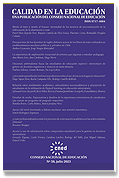Ambivalent Discourse toward Female students in Higher Education: Gender Stereotyping by Engineering Teachers and Technicians in Stem-Mining
DOI:
https://doi.org/10.31619/caledu.n58.1313Keywords:
estereotipos, docentes, ambivalencias, género, educación superiorAbstract
This study was carried out in Engineering Schools and Technical Training Centers in the Antofagasta Region, Chile -the epicenter of mining worldwide It reveals the gender stereotypes of male/female teachers regarding women in mining careers, in a productive context that aspires to the parity by 2050. Through a qualitative, descriptive and comparative study, 23 semi-structured interviews were conducted with male and female teachers, engineers and technicians. Based on the theory of gender and ambivalent sexism, a thematic analysis was carried out, identifying categories and subcategories. Results verified that the female teachers are demanding and benevolent in their judgments, and the male teachers accentuate the attributes linked to the female students: order, responsibility and respect. Both segments transmit their own knowledge, regarding the ways of being, relating and developing and reflect dichotomies in their speeches, unconsciously hindering the training of young people. Therefore, it is a challenge for higher education programs to incorporate strategies that reverse ambivalences and the role that gender constructs play in the training of women, to modify the hidden academic culture that sustains segregation and the set of imperceptible resistances in professional training.
Downloads
Published
Issue
Section
License
Authors retain their Copyright and only transfer a part of these to the journal, accepting the following conditions:
Authors keep their rights as authors and guarantee the right to the journal for the first publication of their work, which is simultaneously subject to the Creative Commons Attribution license allowing third parties to share the study accrediting the author and first publication in this journal.
Authors may adopt other non-exclusive license agreements for distribution of the version of the published work (e.g. inclusion in an institutional thematic file or publication in a monographic volume) accrediting initial publication in this journal.
Authors are allowed and recommended to share their work over the Internet (e.g. in institutional telematic files or their website) before and during the submission process, which may lead to interesting exchanges and increased citation of the published work. (See The effect of open access).

